2017 MITSUBISHI iMiEV ABS
[x] Cancel search: ABSPage 65 of 296
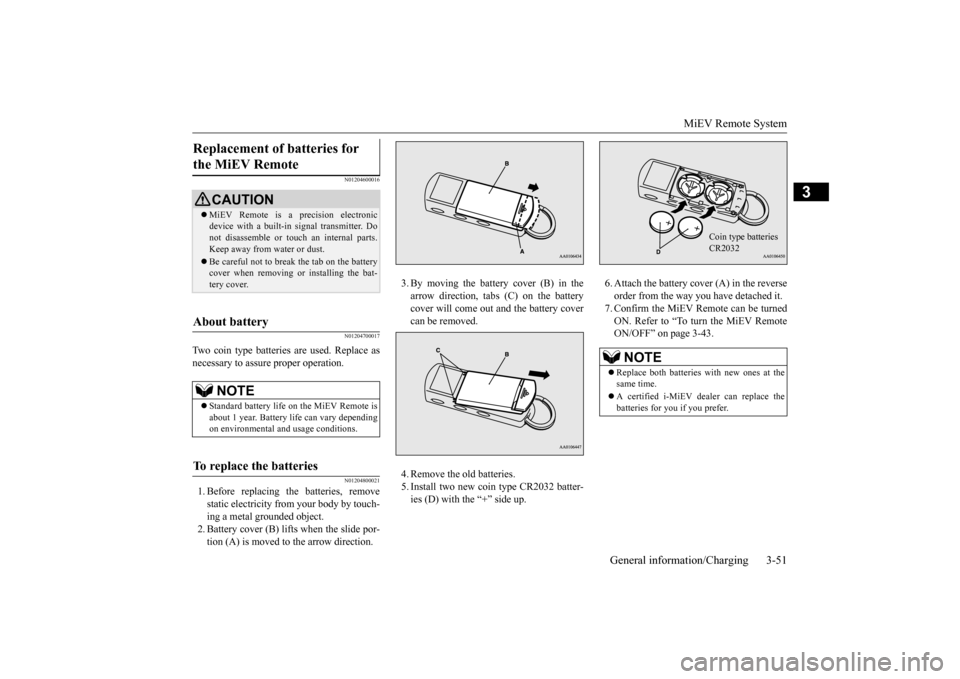
MiEV Remote System
General information/Charging 3-51
3
N01204600016 N01204700017
Two coin type batteries are used. Replace as necessary to assure proper operation.
N01204800021
1. Before replacing the batteries, removestatic electr
icity from your body by touch-
ing a metal grounded object. 2. Battery cover (B) lifts when the slide por- tion (A) is moved to the arrow direction.
3. By moving the battery cover (B) in the arrow direction, tabs (C) on the batterycover will come out
and the battery cover
can be removed. 4. Remove the old batteries. 5. Install two new coin type CR2032 batter- ies (D) with the “+” side up.
6. Attach the battery c
over (A) in the reverse
order from the way you have detached it.7. Confirm the MiEV Remote can be turned ON. Refer to “To turn the MiEV Remote ON/OFF” on page 3-43.
Replacement of batteries for the MiEV Remote
CAUTION MiEV Remote is a precision electronic device with a built-in
signal transmitter. Do
not disassemble or touc
h an internal parts.
Keep away from water or dust. Be careful not to break the tab on the battery cover when removing or installing the bat- tery cover.
About battery
NOTE
Standard battery life on the MiEV Remote is about 1 year. Battery li
fe can vary depending
on environmental and usage conditions.
To replace the batteries
NOTE
Replace both batt
eries with new ones at the
same time. A certified i-MiEV de
aler can replace the
batteries for you if you prefer.
Coin type batteriesCR2032
BK0220401US.book 51 ページ 2015年6月3日 水曜日 午前7時42分
Page 100 of 296
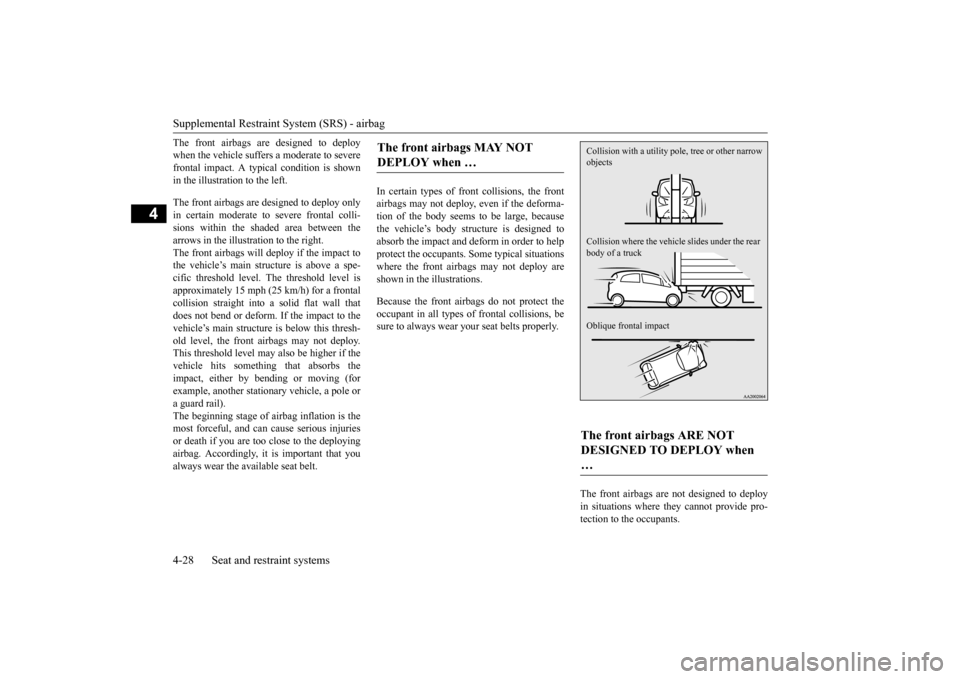
Supplemental Restraint System (SRS) - airbag 4-28 Seat and restraint systems
4
The front airbags are designed to deploy when the vehicle suffers a moderate to severefrontal impact. A typi
cal condition is shown
in the illustration to the left. The front airbags are designed to deploy only in certain moderate to
severe frontal colli-
sions within the shaded area between the arrows in the illustration to the right. The front airbags will deploy if the impact tothe vehicle’s main stru
cture is above a spe-
cific threshold level.
The threshold level is
approximately 15 mph (25 km/h) for a frontal collision straight into a solid flat wall that does not bend or deform. If the impact to thevehicle’s main structure is below this thresh- old level, the front airbags may not deploy. This threshold level may
also be higher if the
vehicle hits somethi
ng that absorbs the
impact, either by bending or moving (for example, another stati
onary vehicle, a pole or
a guard rail). The beginning stage of airbag inflation is the most forceful, and can
cause serious injuries
or death if you are too close to the deploying airbag. Accordingly, it is important that you always wear the available seat belt.
In certain types of front collisions, the front airbags may not deploy, even if the deforma- tion of the body seems to be large, because the vehicle’s body structure is designed toabsorb the impact and deform in order to help protect the occupants.
Some typical situations
where the front airbags may not deploy are shown in the illustrations. Because the front airbags do not protect the occupant in all types of
frontal collisions, be
sure to always wear your seat belts properly.
The front airbags are not designed to deploy in situations where they cannot provide pro-tection to the occupants.
The front airbags MAY NOT DEPLOY when …
The front airbags ARE NOT DESIGNED TO DEPLOY when … Collision with a utility pole
, tree or other narrow
objects Collision where the vehicle
slides under the rear
body of a truck Oblique frontal impact
BK0220401US.book 28 ページ 2015年6月3日 水曜日 午前7時42分
Page 104 of 296
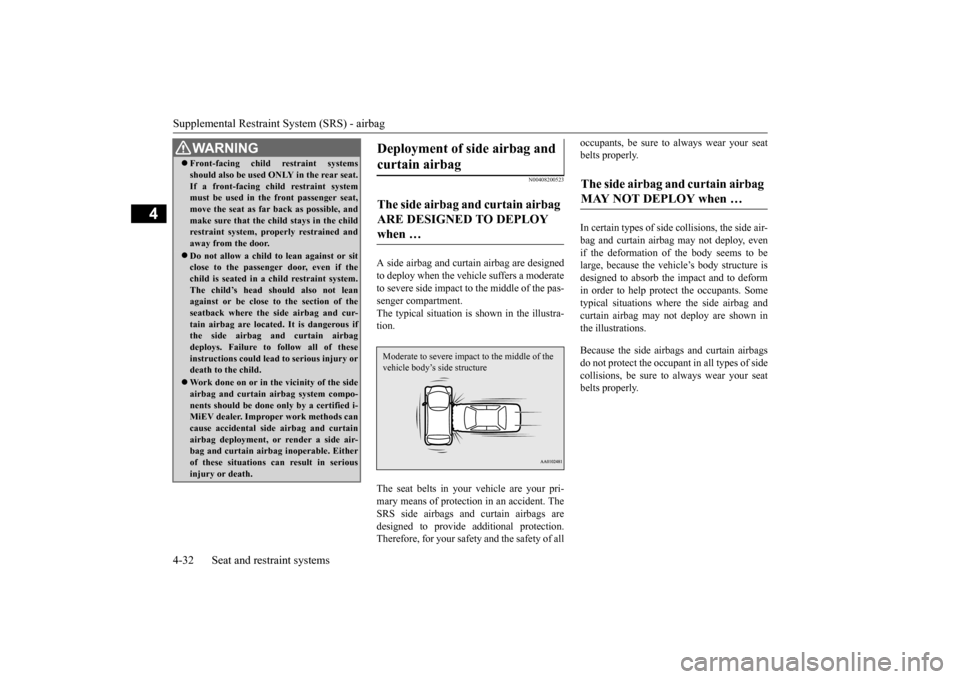
Supplemental Restraint System (SRS) - airbag 4-32 Seat and restraint systems
4
N00408200523
A side airbag and curtain airbag are designed to deploy when the vehicle suffers a moderate to severe side impact to the middle of the pas- senger compartment. The typical situation is shown in the illustra- tion. The seat belts in your
vehicle are your pri-
mary means of protecti
on in an accident. The
SRS side airbags and curtain airbags are designed to provide
additional protection.
Therefore, for your safety and the safety of all
occupants, be sure to
always wear your seat
belts properly. In certain types of side
collisions, the side air-
bag and curtain airbag may not deploy, even if the deformation of the body seems to belarge, because the vehicle’s body structure is designed to absorb the impact and to deform in order to help prot
ect the occupants. Some
typical situations where the side airbag and curtain airbag may not deploy are shown inthe illustrations. Because the side airbags and curtain airbags do not protect the occupant in all types of side collisions, be sure to
always wear your seat
belts properly.
Front-facing child restraint systems should also be used ON
LY in the rear seat.
If a front-facing child restraint systemmust be used in the front passenger seat, move the seat as far back as possible, and make sure that the child stays in the childrestraint system, properly restrained and away from the door. Do not allow a child to lean against or sit close to the passenger door, even if the child is seated in a child restraint system.The child’s head sh
ould also not lean
against or be close to the section of the seatback where the side airbag and cur-tain airbag are located. It is dangerous if the side airbag and curtain airbag deploys. Failure to follow all of theseinstructions could lead to serious injury or death to the child. Work done on or in th
e vicinity of the side
airbag and curtain airbag system compo- nents should be done only by a certified i-MiEV dealer. Improper
work methods can
cause accidental side airbag and curtain airbag deployment, or
render a side air-
bag and curtain airb
ag inoperable. Either
of these situations can result in serious injury or death.WA R N I N G
Deployment of side airbag and curtain airbag The side airbag and curtain airbag ARE DESIGNED TO DEPLOY when … Moderate to severe impact
to the middle of the
vehicle body’s side structure
The side airbag and curtain airbag MAY NOT DEPLOY when …
BK0220401US.book 32 ページ 2015年6月3日 水曜日 午前7時42分
Page 134 of 296
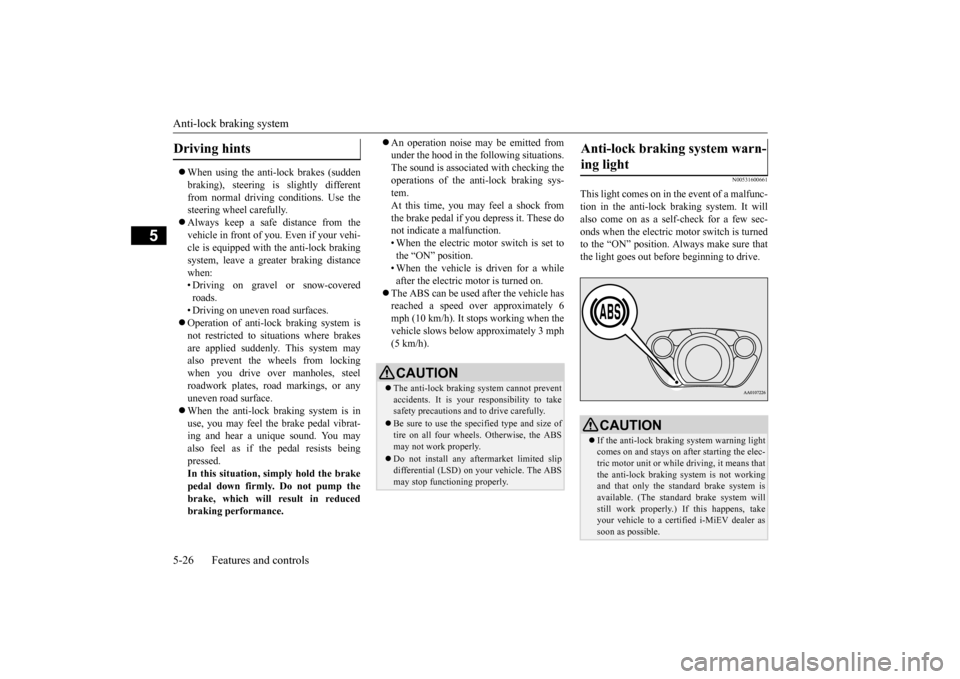
Anti-lock braking system 5-26 Features and controls
5
When using the anti-lock brakes (sudden braking), steering is
slightly different
from normal driving conditions. Use the steering wheel carefully. Always keep a safe distance from the vehicle in front of you. Even if your vehi- cle is equipped with
the anti-lock braking
system, leave a greater braking distance when: • Driving on gravel or snow-covered roads. • Driving on uneven road surfaces. Operation of anti-lock braking system is not restricted to situations where brakes are applied suddenly. This system mayalso prevent the wheels from locking when you drive over manholes, steel roadwork plates, road markings, or anyuneven road surface. When the anti-lock braking system is in use, you may feel the brake pedal vibrat-ing and hear a unique sound. You may also feel as if the pedal resists being pressed.In this situation, simply hold the brake pedal down firmly. Do not pump the brake, which will result in reducedbraking performance.
An operation noise may be emitted from under the hood in the following situations.The sound is associated with checking the operations of the anti-lock braking sys- tem.At this time, you may feel a shock from the brake pedal if you depress it. These do not indicate a malfunction.• When the electric motor switch is set to the “ON” position. • When the vehicle is driven for a while after the electric motor is turned on.
The ABS can be used after the vehicle has reached a speed over approximately 6 mph (10 km/h). It stops working when the vehicle slows below approximately 3 mph(5 km/h).
N00531600661
This light comes on in the event of a malfunc-tion in the anti-lock braking system. It willalso come on as a self-check for a few sec- onds when the electric motor switch is turned to the “ON” position.
Always make sure that
the light goes out befo
re beginning to drive.
Driving hints
CAUTIONThe anti-lock braking system cannot prevent accidents. It is your
responsibility to take
safety precautions and to drive carefully. Be sure to use the spec
ified type and size of
tire on all four wheels. Otherwise, the ABS may not work properly. Do not install any aftermarket limited slip differential (LSD) on your vehicle. The ABSmay stop functioning properly.
Anti-lock braking system warn- ing light
CAUTION If the anti-lock braking system warning light comes on and stays on af
ter starting the elec-
tric motor unit or while driving, it means that the anti-lock braking system is not workingand that only the standard brake system is available. (The standard brake system will still work properly.) If this happens, takeyour vehicle to a certif
ied i-MiEV dealer as
soon as possible.
BK0220401US.book 26 ページ 2015年6月3日 水曜日 午前7時42分
Page 135 of 296

Electric power steering system (EPS)
Features and controls 5-27
5
N00531700590
Avoid hard braking and high-speed driving. Stop the vehicle in a safe place, put the selec- tor lever to the “P” (PARK) position and turn off the electric motor unit. Restart the electric motor unit and check tosee whether the light goes out after a few minutes driving; if it then remains off during driving, there is no problem.However, if the warning light does not disap- pear, or if it comes on
again when the vehicle
is driven, we recommend you to have thevehicle checked. The ABS and brake force distribution func- tion may not work, so hard braking could make the vehicle unstable.Avoid hard braking and high-speed driving. Stop the vehicle in a safe place and we rec- ommend you to have th
e vehicle checked.
N00568400058
The power steering system operates while the electric motor unit is running. It helps reduce the effort needed to turn the steering wheel. The power steering system has mechanicalsteering capability in ca
se the power assist is
lost. If the power assist is lost for some rea- son, you will still be able to steer your vehi-cle, but you will notice it takes much more effort to steer. If this happens, have your vehi- cle inspected at a certified i-MiEV dealer.
If the warning light illuminates while driving If only the ABS warning light illu- minate If the ABS warning light and brake warning light illuminate at the same time
NOTE
The warning light may
be illuminated when
the electric motor unit is started while the12V starter battery voltage
is low, but this is
not an ABS malfunction. When the main drive lithium-ion battery is charged, the 12V starte
r battery is charged at
the same time, and the
warning light will go
out. If the warning light does
not go out or illumi-
nates from time to time even after the battery is charged, take your ve
hicle to a certified i-
MiEV dealer and have
the system checked as
soon as possible. After driving on snow or icy roads, remove any snow and ice whic
h may have been left
around the wheels. On ve
hicles that have an
anti-lock braking system, be careful not todamage the wheel spee
d sensors (A) or the
cables located at each wheel.Front
Electric power steering sys- tem (EPS) Rear
BK0220401US.book 27 ページ 2015年6月3日 水曜日 午前7時42分
Page 136 of 296
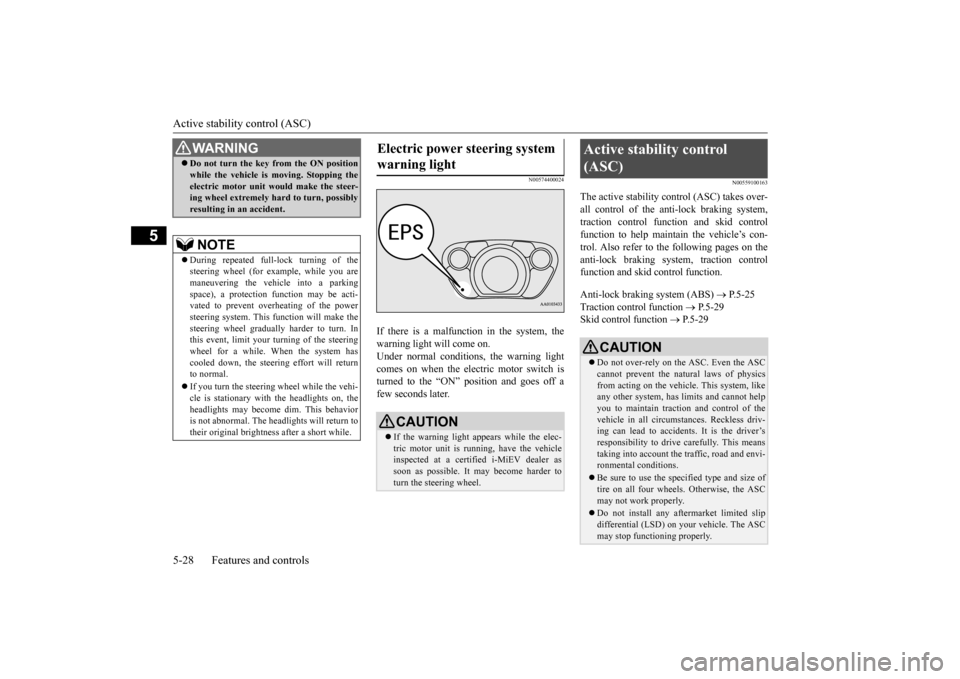
Active stability control (ASC)
5
N00574400024
If there is a malfunction in the system, the warning light will come on.Under normal conditions
, the warning light
comes on when the electric motor switch is turned to the “ON” position and goes off afew seconds later.
N00559100163
The active stability c
ontrol (ASC) takes over-
all control of the anti-lock braking system, traction control function and skid controlfunction to help maintain the vehicle’s con- trol. Also refer to the following pages on the anti-lock braking system, traction controlfunction and skid control function. Anti-lock braking system (ABS)
P.5-25
Traction control function
P.5-29
Skid control function
P.5-29
WA R N I N GDo not turn the key from the ON position while the vehicle is moving. Stopping theelectric motor unit would make the steer-ing wheel extremely hard to turn, possibly resulting in an accident.NOTE
During repeated full-lock turning of the steering wheel (for example, while you aremaneuvering the vehicle into a parking space), a protection
function may be acti-
vated to prevent overheating of the powersteering system. This f
unction will make the
steering wheel gradually harder to turn. In this event, limit your turning of the steeringwheel for a while. When the system has cooled down, the steering effort will return to normal. If you turn the steering wheel while the vehi- cle is stationary with
the headlights on, the
headlights may become
dim. This behavior
is not abnormal. The headlights will return to their original brightne
ss after a short while.
Electric power steering system warning light
CAUTION If the warning light a
ppears while the elec-
tric motor unit is running, have the vehicle inspected at a certified i-MiEV dealer as soon as possible. It may become harder toturn the steering wheel.
Active stability control (ASC)
CAUTION Do not over-rely on the ASC. Even the ASC cannot prevent the natural laws of physics from acting on the vehicle. This system, like any other system, has li
mits and cannot help
you to maintain traction and control of the vehicle in all circumstances. Reckless driv- ing can lead to accident
s. It is the driver’s
responsibility to drive carefully. This means taking into account the tr
affic, road and envi-
ronmental conditions. Be sure to use the specified type and size of tire on all four wheels
. Otherwise, the ASC
may not work properly. Do not install any aftermarket limited slip differential (LSD) on
your vehicle. The ASC
may stop functioning properly.
BK0220401US.book 28 ページ 2015年6月3日 水曜日 午前7時42分
Page 238 of 296
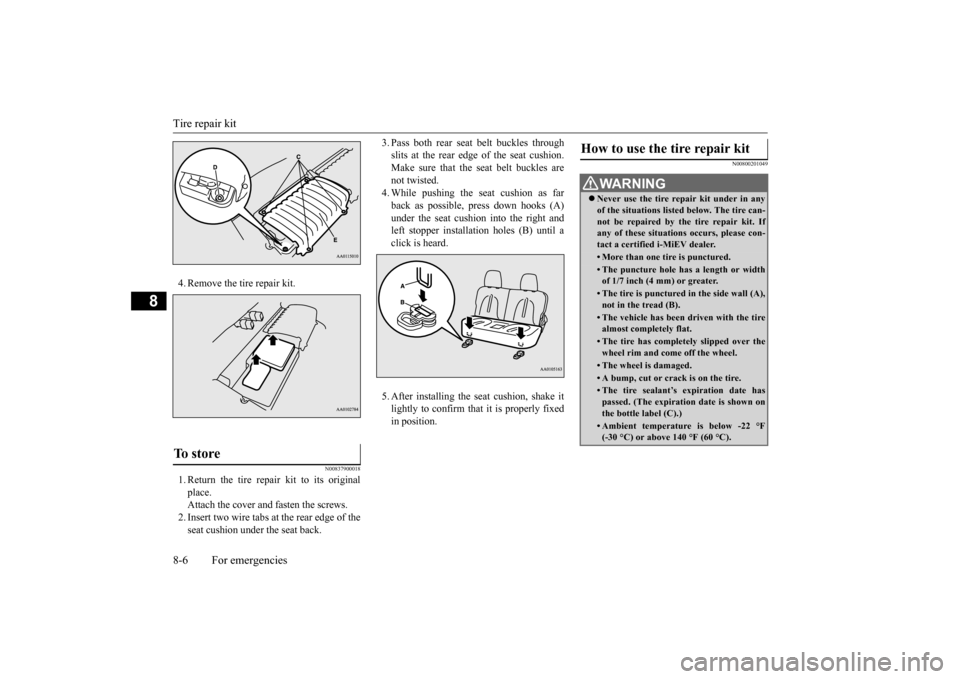
Tire repair kit 8-6 For emergencies
8
4. Remove the tire repair kit.
N00837900018
1. Return the tire repair kit to its original place. Attach the cover and fasten the screws.2. Insert two wire tabs at
the rear edge of the
seat cushion under the seat back.
3. Pass both rear seat
belt buckles through
slits at the rear edge of the seat cushion.Make sure that the seat belt buckles are not twisted. 4. While pushing the seat cushion as farback as possible, press down hooks (A) under the seat cushion into the right and left stopper installa
tion holes (B) until a
click is heard. 5. After installing the seat cushion, shake it lightly to confirm that it is properly fixedin position.
N00800201049
To store
How to use the tire repair kit
WA R N I N G Never use the tire repair kit under in any of the situations listed below. The tire can-not be repaired by the tire repair kit. If any of these situations occurs, please con- tact a certified i-MiEV dealer.• More than one tire is punctured.• The puncture hole has a length or width of 1/7 inch (4 mm) or greater.• The tire is punctured in the side wall (A),not in the tread (B).• The vehicle has been driven with the tirealmost completely flat.• The tire has completely slipped over thewheel rim and come off the wheel.• The wheel is damaged.• A bump, cut or crack is on the tire.• The tire sealant’s expiration date has passed. (The expiration date is shown onthe bottle label (C).)(-30 °C) or above 140 °F (60 °C).
BK0220401US.book 6 ページ 2015年6月3日 水曜日 午前7時42分
Page 245 of 296
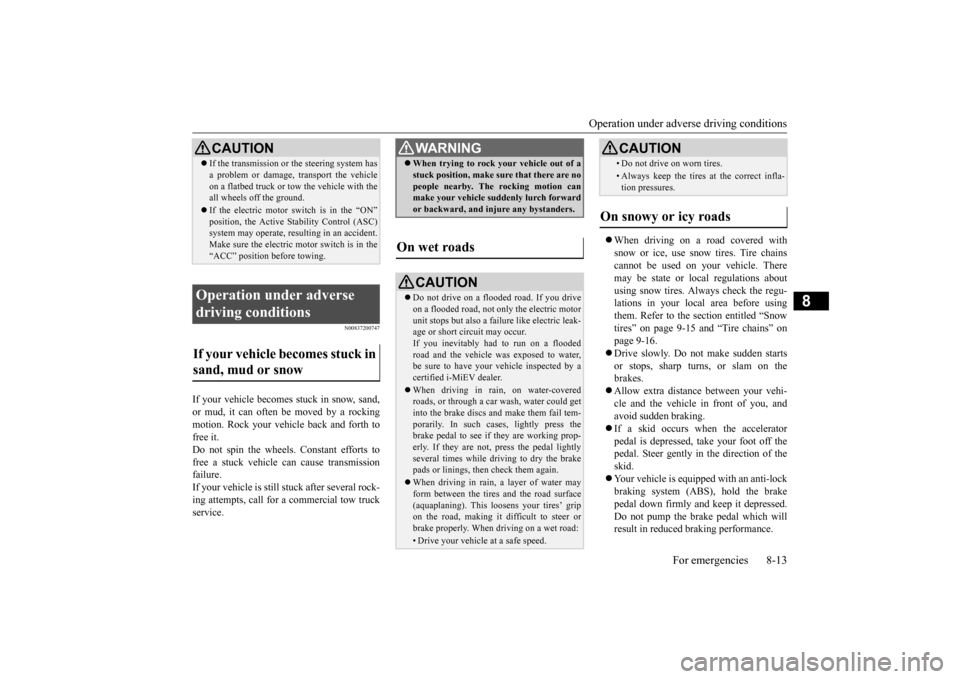
Operation under adverse driving conditions
For emergencies 8-13
8
N00837200747
If your vehicle becomes stuck in snow, sand, or mud, it can often be moved by a rocking motion. Rock your vehicle back and forth tofree it. Do not spin the wheels. Constant efforts to free a stuck vehicle can cause transmissionfailure. If your vehicle is still
stuck after several rock-
ing attempts, call for a commercial tow truckservice.
When driving on a road covered with snow or ice, use snow tires. Tire chains cannot be used on your vehicle. Theremay be state or local regulations about using snow tires. Always check the regu- lations in your local area before usingthem. Refer to the section entitled “Snow tires” on page 9-15 and “Tire chains” on page 9-16. Drive slowly. Do not make sudden starts or stops, sharp turns, or slam on the brakes. Allow extra distance between your vehi- cle and the vehicle in front of you, and avoid sudden braking. If a skid occurs when the accelerator pedal is depressed, take your foot off the pedal. Steer gently in the direction of theskid. Your vehicle is equippe
d with an anti-lock
braking system (ABS), hold the brakepedal down firmly and
keep it depressed.
Do not pump the brake pedal which will result in reduced braking performance.
CAUTION If the transmission or the steering system has a problem or damage,
transport the vehicle
on a flatbed truck or to
w the vehicle with the
all wheels off the ground. If the electric motor switch is in the “ON”
lting in an accident.
Make sure the electric motor switch is in the“ACC” position before towing.
Operation under adverse driving conditions If your vehicle becomes stuck in sand, mud or snow
WA R N I N G When trying to rock
your vehicle out of a
stuck position, make sure that there are nopeople nearby. The
rocking motion can
make your vehicle suddenly lurch forward or backward, and inju
re any bystanders.
On wet roads
CAUTIONDo not drive on a flooded road. If you drive on a flooded road, not only the electric motorunit stops but also a fail
ure like electric leak-
age or short circuit may occur. If you inevitably had to run on a floodedroad and the vehicle was exposed to water, be sure to have your vehicle inspected by a certified i-MiEV dealer. When driving in rain, on water-covered roads, or through a car wash, water could getinto the brake discs and make them fail tem- porarily. In such cases, lightly press the brake pedal to see if they are working prop-erly. If they are not, press the pedal lightlyseveral times while driv
ing to dry the brake
pads or linings, then check them again. When driving in rain, a layer of water may form between the tires and the road surface (aquaplaning). This l
oosens your tires’ grip
on the road, making it difficult to steer or brake properly. When driving on a wet road:• Drive your vehicle at a safe speed.
• Do not drive on worn tires.• Always keep the tires at the correct infla- tion pressures.
On snowy or icy roads
CAUTION
BK0220401US.book 13 ページ 2015年6月3日 水曜日 午前7時42分